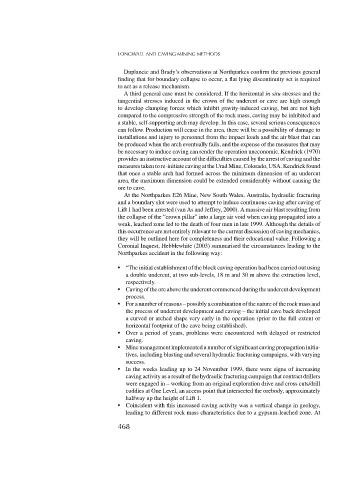Page 486 - Rock Mechanics For Underground Mining
P. 486
LONGWALL AND CAVING MINING METHODS
Duplancic and Brady’s observations at Northparkes confirm the previous general
finding that for boundary collapse to occur, a flat lying discontinuity set is required
to act as a release mechanism.
A third general case must be considered. If the horizontal in situ stresses and the
tangential stresses induced in the crown of the undercut or cave are high enough
to develop clamping forces which inhibit gravity-induced caving, but are not high
compared to the compressive strength of the rock mass, caving may be inhibited and
a stable, self-supporting arch may develop. In this case, several serious consequences
can follow. Production will cease in the area, there will be a possibility of damage to
installations and injury to personnel from the impact loads and the air blast that can
be produced when the arch eventually fails, and the expense of the measures that may
be necessary to induce caving can render the operation uneconomic. Kendrick (1970)
provides an instructive account of the difficulties caused by the arrest of caving and the
measures taken to re-initiate caving at the Urad Mine, Colorado, USA. Kendrick found
that once a stable arch had formed across the minimum dimension of an undercut
area, the maximum dimension could be extended considerably without causing the
ore to cave.
At the Northparkes E26 Mine, New South Wales, Australia, hydraulic fracturing
and a boundary slot were used to attempt to induce continuous caving after caving of
Lift 1 had been arrested (van As and Jeffrey, 2000). A massive air blast resulting from
the collapse of the “crown pillar” into a large air void when caving propagated into a
weak, leached zone led to the death of four men in late 1999. Although the details of
this occurrence are not entirely relevant to the current discussion of caving mechanics,
they will be outlined here for completeness and their educational value. Following a
Coronial Inquest, Hebblewhite (2003) summarised the circumstances leading to the
Northparkes accident in the following way:
“The initial establishment of the block caving operation had been carried out using
a double undercut, at two sub-levels, 18 m and 30 m above the extraction level,
respectively.
Caving of the ore above the undercut commenced during the undercut development
process.
For a number of reasons – possibly a combination of the nature of the rock mass and
the process of undercut development and caving – the initial cave back developed
a curved or arched shape very early in the operation (prior to the full extent or
horizontal footprint of the cave being established).
Over a period of years, problems were encountered with delayed or restricted
caving.
Mine management implemented a number of significant caving propagation initia-
tives, including blasting and several hydraulic fracturing campaigns, with varying
success.
In the weeks leading up to 24 November 1999, there were signs of increasing
caving activity as a result of the hydraulic fracturing campaign that contract drillers
were engaged in – working from an original exploration drive and cross cuts/drill
cuddies at One Level, an access point that intersected the orebody, approximately
halfway up the height of Lift 1.
Coincident with this increased caving activity was a vertical change in geology,
leading to different rock mass characteristics due to a gypsum-leached zone. At
468

